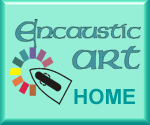 |
 |
||||
|
|||||||||||||||||||
| Fine Art | Hobby Art | Therapeutic | Educational | Products |
  | HISTORY of ENCAUSTIC |
| Encaustic means : "to burn in" This is a process of applying molten wax colours to a surface for the creation of images, decoration and so forth. It started over 2 millennia ago. No one can say for sure exactly what the components of the wax paints were since there are several formulae and a number of application techniques discovered for the creation of the original Roman Egyptian wax portraits. The wax colours appear to have been applied with some swiftness which would certainly make sense if the wax was molten and liable to cool on the brush if not handled with some speed. The Hot Wax Method - is how we might think of encaustic in its truest sense - that is in using heat as the solvent for beeswax based pigmented wax paints. It is generally agreed that there were three tools used in this type of working. Thin wooden panels were usually the best choice for painting onto with molten wax, although linen was also used. Remember that these portraits were designed to be bound into the head area of the mummy wrappings so thin flexible wood was better suited than thick rigid boards. The wax would be heated by some means, perhaps over charcoal?
The Cold Wax method - Punic Wax - Pliny and Dioscorides, both men of Ancient history, give very similar recipes for Punic Wax. They told of a process where beeswax is boiled in salt sea water then strained through cheese cloth to remove impurities. This was done several times. They then decreed that the wax be left in sun or moonlight for several days to better bleach it. After this the wax needed to be saponified (made soap-like) by adding sodium hydrogen carbonate (Sodium Bicarbonate). This was mixed together and then later, drained again through cheesecloth, rinsed in lukewarm water and finally air dried. It would then probably have been tempered for painting by mixing with other naturally available ingredients: These components when combined into a medium and mixed with pigment certainly produce a workable paint that enables results of very similar visual character to those found in Ancient Roman Egypt.
An truly excellent book with magnificent photographs and carefully researched texts is:
| |
 | In 1997 the British Museum held an exhibition of several hundred exhibits, including many encaustic burial portraits.
|  |
| Artemidorus - Egyptian Prince - FAYUM WEBSITE In Ancient Egypt it was customary for those who could afford it (or were accorded it) to have a burial portrait made and bound onto the mummified body of the deceased. Some were painted in Tempera but many were done in encaustic wax. At FAYUM many examples were found. Click Artemidorus to go and see some examples. |
| This whole site is about what is happening to encaustic wax as a medium for art, creativity, relaxation, therapy, eductation and more. You can look pretty much anywhere to discover something interesting and the site is being expended continually to form a resource of information for everyone to browse and use. Our experience of encaustic started in 1986 and has already led many others into a direct exploration and in involvement in this fascinating medium. You could go to this brief article about How to paint with an iron written as a beginners guide to beekeepers not painters! or find out how we got going by clicking on this link which explains a bit about us. |
|
|||||||||||